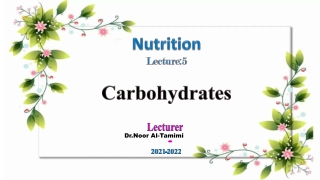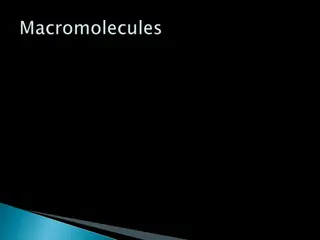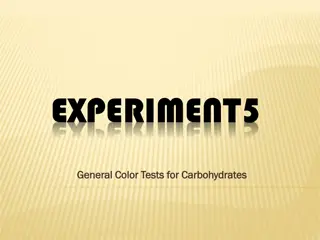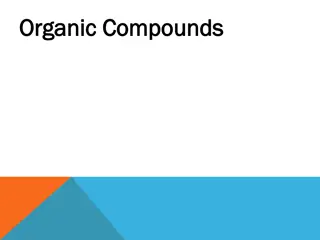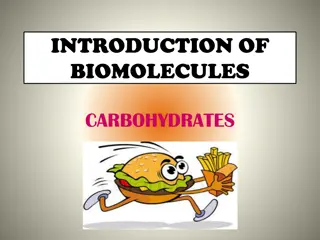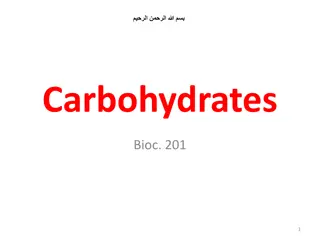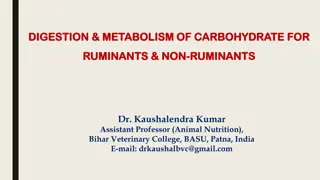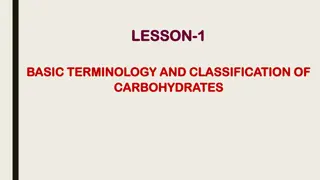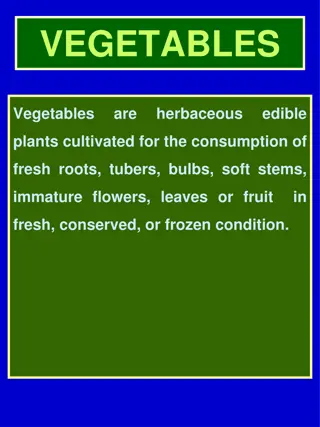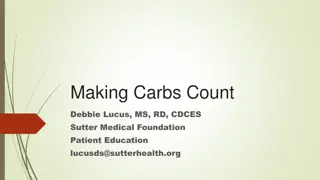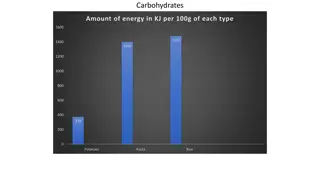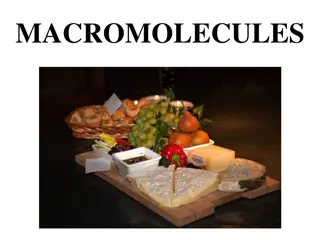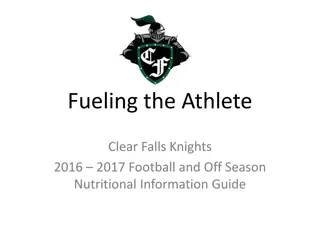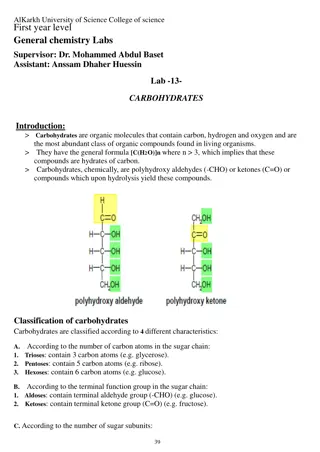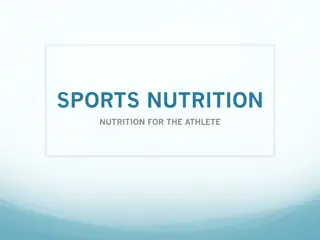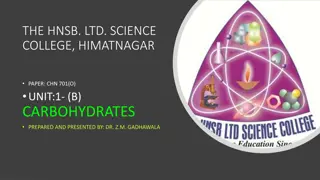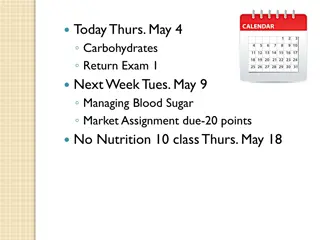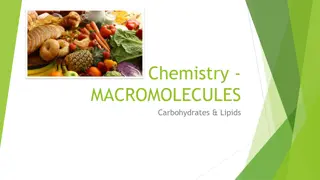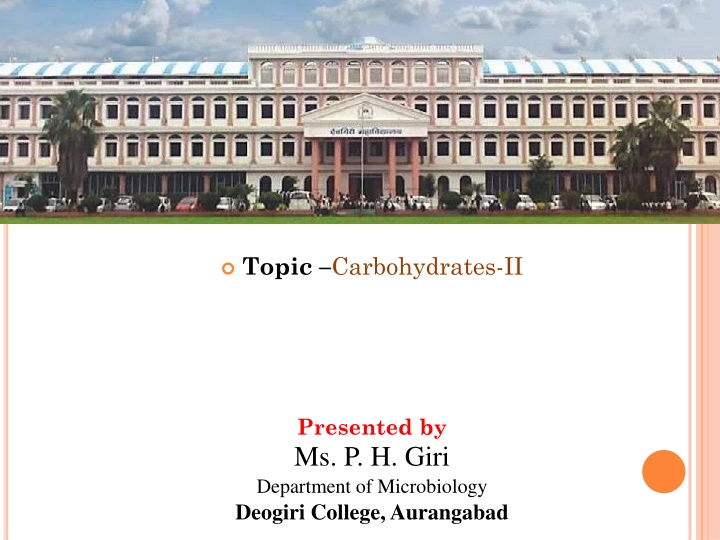
Carbohydrates: Optical Activity, Isomers, and Mutarotation
Explore the fascinating world of carbohydrates with a focus on optical activity, isomers, and mutarotation. Learn about the ability of compounds to rotate plane-polarized light, inter-conversion of alpha and beta isomers, and the structure of glucose in ring form. Delve into the complexities of carbohydrate chemistry presented in an educational setting.
Download Presentation

Please find below an Image/Link to download the presentation.
The content on the website is provided AS IS for your information and personal use only. It may not be sold, licensed, or shared on other websites without obtaining consent from the author. If you encounter any issues during the download, it is possible that the publisher has removed the file from their server.
You are allowed to download the files provided on this website for personal or commercial use, subject to the condition that they are used lawfully. All files are the property of their respective owners.
The content on the website is provided AS IS for your information and personal use only. It may not be sold, licensed, or shared on other websites without obtaining consent from the author.
E N D
Presentation Transcript
Topic Carbohydrates-II Presented by Ms. P. H. Giri Department of Microbiology Deogiri College, Aurangabad
B.SC. F. Y. SEMESTER II PAPER NO. V BASIC BIOCHEMISTRY UNIT 1 CARBOHYDRATES Ms. Priyanka H. Giri
- OPTICAL ACTIVITY It is the ability of the compound to rotate plane polarized light to the right or to the left. Plane polarized light is the light that its waves pass in the same plane by the action of special prisms. If the compound rotates plane polarized light to the right, it is dextrorotatory (d or +). If the compound rotates plane polarized light to the left, it is levorotatory (l or -). The angle of rotation is measured by polarimeter and is affected by many factors such as the source of light, nature and concentration of substance and temperature. Each optically active substance has a specific angle of rotation. For example, the specific rotation for glucose is +52.5 o and for fructose is -91 o.
MUTAROTATION: The inter-conversion of alpha and beta isomers (anomers) is called mutarotation. OR In an aqueous solution the inter-conversion of alpha and beta forms through the open chain structure to give an equilibrium mixture is known as mutarotation. It is the gradual change of rotation observed in freshly prepared solutions of sugars with free aldehyde or ketone groups. Freshly prepared D-glucose solution has an angle of rotation +112Owhich gradually decreases to become constant at +52.5O. Also freshly prepared D-glucose solution has an angle of rotation +19Owhich gradually increases to become constant at +52.5O. Mutarotation results from spontaneous change of two forms and vice versa through the straight chain formula.
STRUCTURE OF GLUCOSE: RING STRUCTURE, HAWORTH & FISHER S PROJECTION Glucose in open chain structure does not show mutarotation In order to explain these properties, which are not consistent with the open chain structure, a ring structure was proposed for glucose. Cyclic structure of glucose: Ring structure of Glucose explain the properties which are not explained by open chain structure because Ring structure has no free aldehydic group, glucose does not respond to certain characteristic tests of aldehydes, like Schiff s test and addition reaction with sodium- - bisulphite. The cyclic structure is attributed to the formation of hemiacetal the cyclic structure thus formed is a six-membered ring. This cyclic structure has one chiral centre more than the open chain structure. Therefore, two possible isomeric forms are possible.
CYCLIC STRUCTURE OF FRUCTOSE: Fructose is a ketone and consists of six carbon atoms in a straight chain with the keto functional group at position 2 of the carbon chain. As the open chain structure fails to explain certain facts like its existence in two isomeric forms and the formation of hydrogen sulphite addition product, the ring structure was established.
DERIVED MONOSACCHARIDES: Derived monosaccharides differ from normal monosaccharides with respect to aldoses and ketoses. They include the glycosides, sugar phosphates, gluconic acid, glucruonic acid, amino sugars and vitamin C. 1. Glycosides. The hydroxyl group on carbon 1 in the sugar molecule can be replaced by other radicals, forming compound known as glycosides. There are two methyl glucosides possible, and , corresponding to the and forms of glucose. Glucosides formed from galactose are known as galactosides.
Glycosides are defined as the organic compounds obtained from plant or animal source which on enzymatic or acid hydrolysis gives one or more sugar moieties along with non-sugar moiety. The sugar moiety is called as glycone & non-sugar moiety called as aglycone or genin.
2. SUGAR PHOSPHATES. C-1 or C-6 of glucoase can react with phosphoric acid (H3PO4) to yield glucose-1-phosphate and glucose-6-phosphate, respectively. These compound play an important part in carbohydrate metabolism.
3. URONIC ACIDS : GLUCONIC ACID, GLUCURONIC ACID. Oxidation of C-1 of the glucose molecule to a carboxyl group yields gluconic acid. Production of a carboxyl group at C-6 yields glucuronic acid. The corresponding terms for any hexoses are hexonic acid and hexuronic acid. Glucuronic acid is an important constituent of complex polysaccharides and is also an important coupling agent. Many drugs, pesticides, and environmental pollutants and harmones are coupled with glucuronic acid and excreted in urine or bile as glucuronides.
4. AMINO SUGARS OR HEXOSAMINES: are formed when an amino sugar is introduced into hexoses. Thus glucose with NH2 at C-2 forms glucosamine. This compound is extensively found in complex polysaccharides, usually in the form of its acetyl derivative N-acetyl glucosamine. N-acetyl galactosamine, the amino derivative of galactose is found in glycoproteins and glycolipids.
5. SUGAR ALCOHOLS: Sugar alcohols (also called polyhydric alcohols, polyalcohols, alditols or glycitols) are organic compounds, typically derived from sugars, that comprise a class of polyols. Sugar alcohols have the general formula HOCH2(CHOH)nCH2OH. The sugar alcohols differ in chain length. Most have five- or six- carbon chains, because they are derived from pentoses (five-carbon sugars) and hexoses (six- carbon sugars), respectively. They have one OH group attached to each carbon.
GLYCOSIDIC LINKAGE: A glycosidic bond or glycosidic linkage is a type of covalent bond that joins a carbohydrate (sugar) molecule to another group, which may or may not be another carbohydrate. A glycosidic bond is formed between the hemiacetal or hemiketal group of a saccharide (or a molecule derived from a saccharide) and the hydroxyl group of some compound such as an alcohol. A substance containing a glycosidic bond is a glycoside By convention glycosidic linkages are named by reading from left to right.
B) DISACCHARIDES (COMPOSED OF TWO MONOSACCHARIDES) EXAMPLE: SUCROSE, LACTOSE, MALTOSE A disaccharide consists of two monosaccharides joined by an O-glycosidic bond. Disaccharides can be homo- and heterodisaccharide. Three most abundant disaccharides are sucrose, lactose, and maltose. In sucrose the anomeric carbon atoms of a glucose unit and a fructose unit are joined. Lactose, the disaccharide of milk, consists of galactose joined to glucose by a (1 4) glycosidic linkage. In maltose, (1 4) glycosidic linkage joins two glucose units. Sucrose and lactose are heterosaccharides and maltose is homosaccharide.
1. SUCROSE ( COMMON TABLE SUGAR ) It is obtained commercially from sugarcane or sugar beets. Sucrose can be cleaved into it s component mono- saccharides by the enzyme sucrase (in animals) and invertase (in plants) Also read as -D-glucopyranosyl-(1-2)- -D- fructofuranose
2. MALTOSE (MALT SUGAR) It is found in germinating seeds and malt. It is also produced during the digestion of starch by -amylase enzyme. Also read as -D-glucopyranosyl-(1-4)- -D- glucopyranose.
3. LACTOSE ( MILK SUGAR) Lactose is hydrolyzed by lactase enzyme in human and beta galactosidase in bacteria. Also read as -D-galactopyranosyl-(1-4)- -D- glucopyranose. Lactose

